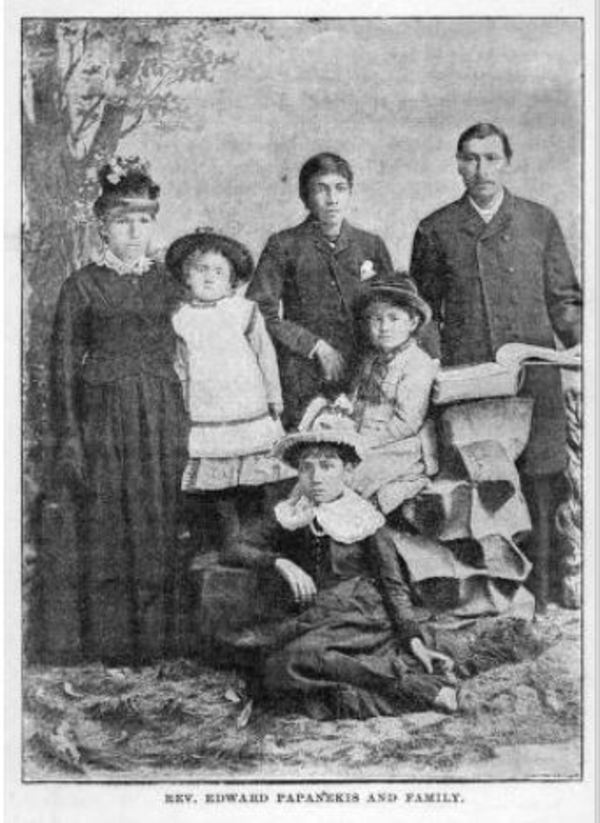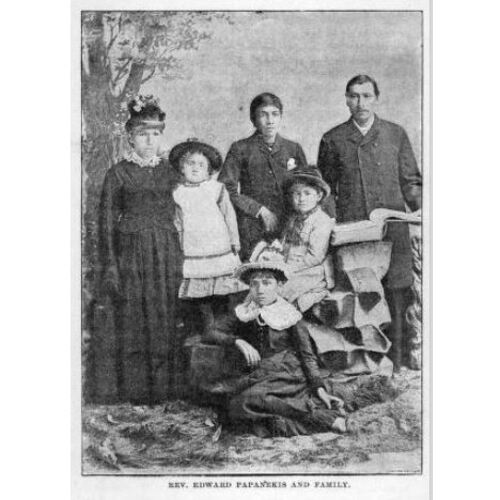
Source: Link
PAUPANEKIS (Papanekis, Paupanakiss, Paupanikas, Paupaunakis), EDWARD, Swampy Cree, HBC employee, interpreter, schoolteacher, and Methodist missionary; b. 20 April 1840 in Norway House (Man.), youngest son of William Papanekis and Ann (Hannah) Oo-tas-a-mus; m. 6 Oct. 1863 Margaret Stevenson (d. 1927) in Rossville (Man.), and they had two sons and five daughters; d. 26 July 1911 in Warrens Landing (Man.).
Edward Paupanekis’s father, known for some time as Papathekis, was a Swampy Cree hunter, originally part of the Home Guard (hunters who traded with the Hudson’s Bay Company and lived near its posts) at York Factory. He had moved inland to the vicinity of Norway House as early as 1813 and by the summer of 1840 he was a leading hunter there. That same summer James Evans* established a Methodist mission at Norway House and within two years Papathekis, known by then as William Papanekis, his wife, Ann, and their nine children were baptized. After settling his family at the nearby mission community of Rossville, William became a leader in the church there, as did several of his children, but Edward was slow to answer the call. Tall and strongly built like his father and brothers, he was fluent in English, which made him a likely prospect for work with the Hudson’s Bay Company. He was employed as a labourer from 1861 to 1863, as a runner and midman from 1867 to 1871, and as a runner from 1873 to 1875.
Paupanekis worked on the York boats during the summer and travelled to the native camps in the winter, either taking out supplies or bringing in furs, although in January 1865 he almost turned back from one such journey because “he got into a row at the Village [Rossville] with one of the free traders.” While working for the HBC he also acquired a liking for whisky, which neither his marriage in 1863 nor the death of his eldest child in 1865 eliminated. A turning-point came in 1873 when, under the influence of alcohol, he created a ruckus at the home of the Reverend Egerton Ryerson Young*, the Methodist missionary at Rossville. Young began to work more closely with Paupanekis, who subsequently felt deep remorse for what he had done. In the words of Young’s wife, Elizabeth*, “Soon the blessed truth reached his heart and it was Mr. Youngs joy to see him a humble Suppliant at the Cross.”
In 1874 another turning-point occurred when the Reverend John Semmens* arrived in Norway House on his way to establish a mission at Nelson House. Paupanekis agreed to act as his interpreter and schoolteacher, but did not join him until March 1875 because of his obligation to the HBC. According to Semmens, who spoke no Cree, it was when Paupanekis arrived with his family that the “evangelistic effort began in dead earnest.” Semmens was transferred to Berens River in 1876. Since no ordained missionary was available to replace him, Paupanekis stayed on at Nelson House as a lay missionary until about 1880. Then he returned to Norway House, where he was the local preacher for eight years. His long service and the shortage of ordained men for the northern missions were factors which influenced the Winnipeg district of the Methodist Church of Canada to recommend in 1889 that he be accepted on probation for the ministry. The first Cree from a northern Manitoba community to be so honoured, Paupanekis received special ordination at Grace Church, Winnipeg, on 23 June 1889 during the annual meeting of the Manitoba and North-West Conference. Thereafter, he served from 1889 to 1895 at Oxford House, from 1895 to 1903 at Cross Lake, and from 1903 to 1911 at Norway House.
Some idea of his character can be gleaned from the memories of those who knew him. In 1904, when Paupanekis was well up in years, the Reverend John Chantler McDougall, describing his remarkable stamina, wrote, “Brother Papanakis is keenly alive; paddle and muscle, nerve and eye are all alert, and thus we fly across the open water of the inland lake.” Semmens said that he was “highly respected by all who knew him. He had a fair knowledge of the word of God and was gifted with the ability to express his ideas in a clear and convincing manner.” The Reverend Joseph Jones described him as a “perfect Christian gentleman . . . an outstanding eloquent preacher.” The source of that eloquence, indeed the heart of his ministry, was perhaps best summed up in an obituary, which noted his “intense desire for the uplift of his own people . . . and his unbounded faith in the possibilities of them through the saving power of the Gospel of Christ, augmented by education and a fair chance to make their way in life.”
Hudson’s Bay Company Cemetery (Norway House, Man.), Tombstone inscriptions (transcribed by the contributor, 17 May 1987). NA, RG 15, DII, 8, 1580. PAM, GR 1212; HBCA, B.154/a/66; B.239/u/2, 3. Private arch., J. S. H. Brown (Winnipeg), Biog. file, Edward Paupanekis and family; Kenneth Paupanekis (Winnipeg), Paupanekis family bible. UCC, Manitoba and Northwestern Ontario Conference Arch. (Winnipeg), Biog. file, Edward Paupanikis; Methodist Church, Winnipeg District, minutes, 12 June 1889. Manitoba Sun (Winnipeg), 22 June 1889. Manitoba Weekly Free Press (Winnipeg), 27 June 1889. Methodist Church (Canada, Newfoundland, Bermuda), Manitoba Conference, Minutes (Toronto), 1912. Missionary Bull. (Toronto), 3 (1905–7): 87–94. E. R. Young, By canoe and dog-train among the Cree and Salteaux Indians, intro. M. G. Pearse (London, 1890).
Cite This Article
Raymond M. Beaumont, “PAUPANEKIS (Papanekis, Paupanakiss, Paupanikas, Paupaunakis), EDWARD,” in Dictionary of Canadian Biography, vol. 14, University of Toronto/Université Laval, 2003–, accessed January 13, 2026, https://www.biographi.ca/en/bio/paupanekis_edward_14E.html.
The citation above shows the format for footnotes and endnotes according to the Chicago manual of style (16th edition). Information to be used in other citation formats:
| Permalink: | https://www.biographi.ca/en/bio/paupanekis_edward_14E.html |
| Author of Article: | Raymond M. Beaumont |
| Title of Article: | PAUPANEKIS (Papanekis, Paupanakiss, Paupanikas, Paupaunakis), EDWARD |
| Publication Name: | Dictionary of Canadian Biography, vol. 14 |
| Publisher: | University of Toronto/Université Laval |
| Year of publication: | 1998 |
| Year of revision: | 1998 |
| Access Date: | January 13, 2026 |



